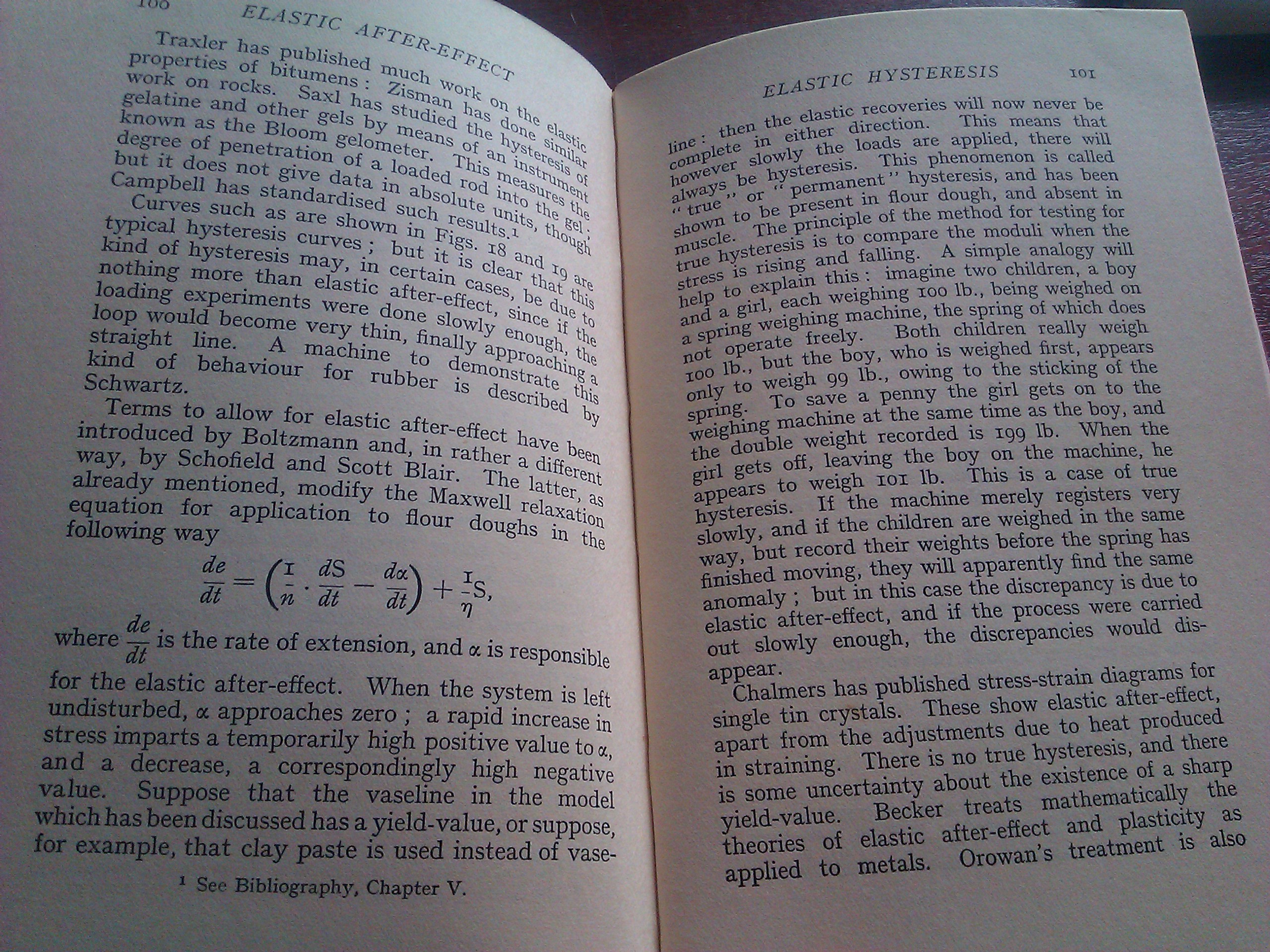57760 str (89)

g| ELASTIC AFTER-Ejt^ ]
Traxler has published much work properties of bitumens : Zisman has° a a work on roćks. Saxl has studied the 5°^ gelatine and other gels by means of known as the Bloom gelometer. This degree of penetration of a loaded rod tu
but it does not give data in absolute units^fl Campbell has standardised such results.iS> □ Curves such as are shown in Figs. 18 anJ typical hysteresis curyes; but it is elear tj land of hysteresis may, in certain cases, be^u
I
nothing morę than elastic after-effect, since^i0 loading experiments were done slowly enough if loop woułd become very thin, finally approaching straight linę. A machinę t^ demonstrate twj kind of behaviour for rubber is describedH Schwartz. v. .
Terms to allow for elastic after-effect have been introduced by Boltzmann and, in rather a.different way, by Schofield and Scott Blair. The latter^ąs already mentioned, modify the Maxwell relaxation eąuation for application to flour doughs in the following way
hm
de _ /i dS __ ^a\ dt~~ \n' dt dt)
de
where — is the ratę of extension, and a,is responsible dt
for the elastic after-effect. When the system iś left undisturbed, a approaches zero; a rapid inerease in stress imparts a temporarily high positive yalue to a, and a decrease, a correspondingly high negative value. Suppose that the vaseline in th^jnodel whichhasbeen discussed has ayield-value, br suppose, for example, that clay pastę is used instead of vase-1 | See Bibliography, Chapter V.
Ili i then the elastic rećoveries will now never be complete in either direction. This means that however slowly the loads are applied, there will always be hysteresis. This phenomenon is called " true ’* or § permanent ” hysteresis, and has been shown to be present in fłour dough, and absent in muscle. The principle of the method for testing for true hysteresis is to compare the modnli when the stress is rising and falling. A simple analogy will help to explain this: imagine two children, a boy and a girl, each weighing ioo lb., being weighed on a spring weighing machinę, the spring of which does not operate freely. Both children really weigh ioo lb., but the boy, who is weighed first, appears only to weigh 99 lb., owing to the sticking of the spring. To save a penny the girl gets on to the weighing machinę at the same time as the boy, and the double weight recorded is 199 lb. When the girl gets off, leaving the boy on the machinę, he appears to weigh 101 lb. This is a case of true hysteresis. If the machinę merely registers very slowly, and if the children are weighed in the same way, but record their weights before the spring has finished moving, they will apparently find the same anomaly; but in this case the discrepancy is due to elastic after-effect, and if the process were carried out slowly enough, the discrepancies would dis-appear.
Chalmers has published Stress-strain diagrams for single tin crystals. These show elastic after-effect, apart from the adjustments due to heat produced in straining. There is no true hysteresis, and there is some uncertainty about the existence of a sharp yield-value. Becker treats mathematically the theories of elastic after-effect and plasticity as applied to metals. Orowan’s treatment is also
Wyszukiwarka
Podobne podstrony:
41994 str (91) ELASTIC AFTER-EnEC7 o6 -NH mCH. CH,. S. S. CH,. CH —CO strong
test2 8. Korzystając z wykresu rozpuszczalności substancji (podręcznik, str. 89) określ, ile g azota
Łacina str? 89 88 Dziewiąty dzień przed Idami nazywał się Nony (Nonae), więc w miesiącach, w których
str 89 Serce, cor 89 V. obligua atrii sinistri Sinus coronarius V. coronaria sinistra___1 V. ventric
Stretching s034 Stretching spontaniczny 10 sek. każde ramię str. 80 15 sek. każda noga str
str? 89 ___— - --- r Z. *** - *>Yt301rsońS:30 «XT^ ±.^‘J f(<*45f« * 70/<
84918 ozdabianie?korowanie potraw garnierowanie food?koration?co str 1 (89) KARBOWANIE KAPELUSZA PIE
32875 str 89 (2) w no. norą inąć dzić. rwać jem-
andstaydead Play this card immedulely after any Group has been destroyed or discarded by any player.
więcej podobnych podstron